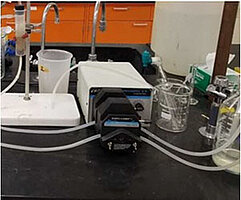Enhanced Removal of Heavy Metals from Stormwater by Bioretention Cells

Nicholas Peterson
Enhanced Removal of Heavy Metals from Stormwater by Bioretention Cells
The objective of this project was to determine what materials had the greatest ability at sequestering copper (II) ions from aqueous solution. Potential sorbent materials were selected. Batch-scale experiments were performed on the sorption of cupper ions (Cu(II)) by different materials, including flocs formed during coagulation/flocculation of surface water treatment, biochar, biomass materials, sand, and iron-modified sand. In addition, laboratory column tests packed with the materials selected for the batch-scale experiments, including flocs and ironmodified sand, were also performed. It was found that high modified iron-coated (MIC) sand was capable of retaining copper (II) ions passed through the column or removing the influent copper (II) ions. The primary discovery gained from the fixed-bed column experiments was that the majority of the sorbent materials were less efficient than the iron-modified sand. This was of particular interest because many of the materials such as tap water flocs had high maximum adsorption capacity values in the batch experiments, which could only be explained by the limited contact time and preferential contaminant flow paths. The major findings from this research include (1) the ranking of materials for maximum adsorption capacity and (2) the materials possessing the greatest retention capacity with contact time constraints.


Feng "Frank" Xiao
Civil Engineering
Office: Upson II Room 260K
243 Centennial Drive Stop 8115
Grand Forks, ND 58202-8115
Telephone: 701-777-5150
Email: feng.xiao@UND.edu


